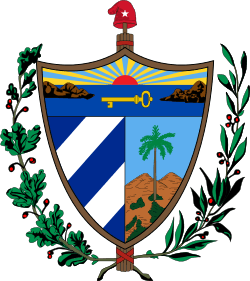Cuba–Peru relations
 |
|
Cuba |
Peru |
|---|---|
Cuba–Peru relations refer to the relationship between the Republic of Cuba and the Republic of Peru. Cuba has an embassy located in Lima, Peru while Peru has an embassy in Havana, Cuba.
History
Relations between the South American states of Cuba and Peru have been troubled since the Cuban revolution brought Fidel Castro to power in 1959. Like all other states in the Americas apart from Canada and Mexico, Peru broke off diplomatic relationships with the newly communist Cuba in the early 1960s.[1][2] While diplomatic ties were re-established on 8 July 1972, the relationship has since been rocked by a succession of incidents. Tensions were aggravated by the Cold War, with Peru tending to side with the US, while Cuba was a loyal ally of the Soviet Union. A destabilizing factor specific to the bilateral relationship was the alleged Cuban support for the Túpac Amaru Revolutionary Movement, an antigovernment guerrilla force that operates in remote rural areas of Peru. [3] The relationship remained rocky even after the cold war ended. An example incident followed Peru's support for a 2004 UN resolution critical of Cuba's human rights record. This prompted Fidel Castro to speak out strongly against Peru and her president, leading Peru to respond by recalling her ambassador.[4][5][6] By 2010 the general improvement in Cuba's foreign relations that had followed the ascension of U.S. President Barack Obama had lost momentum. However both Cuba and Peru were quick to lay aside their differences as they co-operated in delivering humanitarian relief for victims of the 2010 Chile earthquake .[7]
Mariel boatlift of 1980
A small group of Cuban citizens took sanctuary at the Peruvian embassy by smashing through the perimeter fence in a bus. Cuba asked embassy officials to hand the Cubans over to Cuban security officials. Peru refused and the Cuban government responded by withdrawing the Cuban security officers who protected the embassy. About 10,000 Cubans then sought asylum at the embassy. Cuba then opened the port of Mariel and allowed Cubans who wanted to emigrate to leave by boat, prompting the exodus of approximately 125,000.
References
- ↑ Peter McKenna & John M Kirk (2006). "Engaging Revolutionary Cuba" (PDF). revista mexicana de estudios canadienses (Journal of Canadian Studies). Archived from the original (PDF) on 23 September 2012. Retrieved 9 September 2010.
- ↑ "PERU CONSIDERING BREAKING RELATIONS WITH CUBA". CIA document hosted on faqs.org. 9 March 1960. Archived from the original on 11 October 2012. Retrieved 9 September 2010.
- ↑ Kathryn Gregory (27 August 2009). "Shining Path, Tupac Amaru (Peru, leftists)". Council on Foreign Relations. Retrieved 9 September 2010.
- ↑ "Peru Rechaza y Protesta por Declaraciones de Castro (Spanish)". El Comercio (Perú). 2 May 2004. Retrieved 9 September 2010.
- ↑ GINGER THOMPSON (3 May 2004). "Mexico and Peru Withdraw Ambassadors From Cuba". New York Times. Retrieved 9 September 2010.
- ↑ NANCY SAN MARTIN AND ANDRES OPPENHEIMER (3 May 2004). "Peru joins Mexico in suspending Cuba ties". The Miami Herald. Retrieved 9 September 2010.
- ↑ Anastasia Moloney (5 March 2010). "Latin America forgets differences to rally around Chile". Reuters. Retrieved 9 September 2010.
